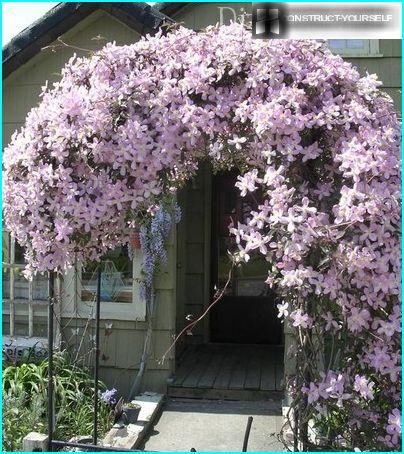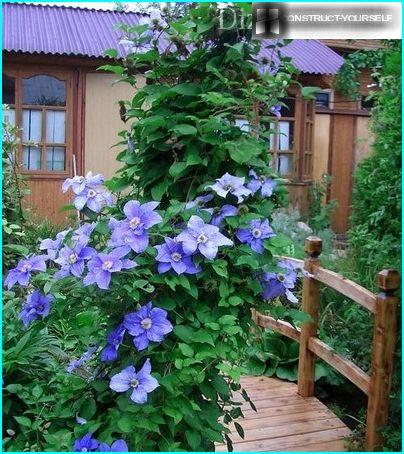
Beautiful plants, studded with a scattering of star-shaped flowers adorn most suburban areas. Delicate stems of clematis climbing a trellis or a support form delicate screens, topped with a lot of fancy flowers with the most incredible forms and colors. These beautiful plants are mainly used for vertical gardening, and to be more decorative, they can only provided on the support. But because support for the clematis with their hands is a constituent element of the competent organization of vertical gardening in landscape design.
The contents
Features of cultivation of clematis
Thin vines, strewn with many beautiful flowers are welcome at many sites. Blooming in early summer, they are able to produce amazing blooms during the whole season.

Large-flowered varieties that can cover up to 4-5 square meters, are elegant decoration of ceremonial area zones: walls, verandas and pergolas, main entrance and front garden
For shading of facades of buildings, caves, ladders and unsightly buildings are perfect small-flowered varieties of clematis.

A hedge of clematis, woven thick carpet of a thousand wondrous flowers, can not only transform the area, but hide it from the prying eyes of passers-by
Clematis plants prefer Sunny areas, but require shading the root system, in simple words «head in the sun and feet in the shade». The second important condition for the cultivation of these flowering plants is placing them on supports. Properly fitted supports under the clematis will give the desired shape compositions and to demonstrate the decorative qualities of plants.
Clematis are most often the center of the design vertical gardening. When choosing plants to decorate the area, consider the biological features of a grade. Wanting to create a falling «cascades» or dressy «garland» better to stop the choice on the variety, which flowers are more focused on the ends of the shoots, for example: Serenade of the Crimea, Birjusinka, Climber. For registration «carpet» songs is better to give preference to the varieties, the flowers of which are uniformly distributed along the vines: Space Melody Alenushka, blue-gray bird.
The types of supports for flowering clematis
Depending on the form of support for the clematis are:
- Arch;
- Pyramidal;
- Fan design.
The main requirements that they imposed: decorative, easy installation and ease of use. Thanks to pillars of the stems of clematis do not break and trampled. With the help of vertical stands can provide adequate ventilation of the plants, which is the key to their rapid development and abundant flowering. Arch – the most common type of garden supports for flowering plants.

Pillar, twined with flowering clematis, besides the fact that he is a nice decorative element for any garden, helping to divide the space into separate functional zones

Simply amazing looks arch, clematis, established in the beginning of the track. It’s like she invites you to stroll through the winding paths of the garden and take in its enchanting beauty
Feel comfortable clematis and pyramidal tripods, made of cane or metal or wicker.

Pyramid supports give good support to the flexible stems of the plants. They look appropriate in the tiered floral compositions and as free-standing structures
To create a cozy romantic corner in the garden where you can be alone on a hot afternoon or cool evening, hiding from the prying eyes of passers-by and enjoying the majestic beauty using the trellis.
What you can build yourself?
The material of manufacture of supports for the clematis can be wood or metal. The thickness of rods and wooden bars, clinging petioles of clematis, should not exceed 10-15 mm. Design build height of 1 to 5 meters or more.
Option #1 — wood trellis
For exterior part of the structure dimensions 180х60 cm you will need:
- Four bar section 50×40 mm with a length of 1.8 meters;
- Four timber section 100х40 mm length 0.6 m;
- One strap section 150х15 mm long, 0.6 meters.
To build internal grid, the size of the cells that make up 25х15 cm, you need to prepare:
- Four rail section 25х15 mm long 1.8 meters;
- Eight strips section 25х15 mm length 0.55 m.
Preparing all necessary elements for a trellis, gather design. To do this, first make two of the outer frame, the bars of which are connected with the help of screwdriver and drill. For the manufacture of the inner sheathing with a tape of proposed cell sizes, and the fastening of the slats between the screws.

Trellis clematis under is a structure consisting of two outer frames, between which is placed a wooden lattice

The grid set between the two outer frames. To give rigidity to the upper side of the trellis can be mounted horizontal bar connecting the outer frame and the sheathing
Trellis ready. It can be placed on the wall of the gazebo or home, leaving the distance between the vertical surface and structure in 10 cm To extend the life of the wooden supports, the surface of the trellis can be covered with paint or varnish.
Option #2 — delicate arched design
To do delicate arch, which will decorate the front area of the site, you need to prepare:
- Four cut tubes with a diameter of 30 mm with a wall thickness of 1.5 mm;
- A metal rod a cross section of 10×10 mm.
- Concrete.
Dimensions of the future design determine the rate where it will be located and what function to perform. Planning to place an arch along the center track, a width of 110 cm, it is necessary to construct a structure width of 120 cm. the Side walls of the arch can be performed in the form of frames on «legs», to fill out that simple patterns of swirls created from metal bars with a thickness of 6-8 mm.

Often arched arches give a semicircular shape, but no less impressive looks of the Lancet, the usual gable or flat option

The individual elements of the pattern are easy to make using «cold forging» or simply by adding a thin rod to a larger diameter pipe
If the flat arches of the designs can be made independently, the bow-shaped arches better to bend at the mill. The support pillar of the arch you can just hammer into the ground, suglobov 70-80 cm Wishing to create a more durable support under flowers, «legs» design should be additionally concreted.
Installing the wall arches, you could weld the arches and connect them at multiple points in the horizontal bars. Assembly drawing of frame – a fascinating creative process.

To simplify the process of creating a twisted pattern, it is preferably of soft aluminum wire to run the templates in actual size, for clarity, are mounted on the strained cords of the frame using stationery clips
First «we catch» large items, performing smooth transitions of the smaller curved parts. When the pattern is fully framed, all parts ovarium from both sides, and then processed from sagging.
Arch collected. It remains only to treat the surface means «rust Converter», and after carefully wash, dry and paint in the desired color.






